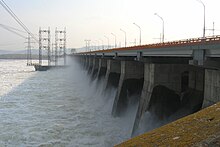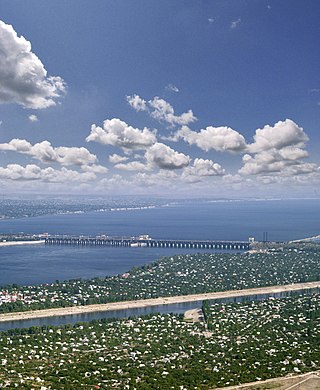
The Volga Hydroelectric Station or Volga GES also known as the 22nd Congress of the CPSU Stalingrad/Volgograd Hydroelectric Power Station, is the largest hydroelectric station in Europe, and the last of the Volga-Kama Cascade of dams, immediately before the Volga River flows into the Caspian Sea. It was the largest powerstation in the world between 1960 and 1963. Today, it is operated by the partly government-owned electricity company RusHydro.

The Sayano-Shushenskaya Dam is located on the Yenisei River, near Sayanogorsk in Khakassia, Russia. It is the largest power plant in Russia and the 12th-largest hydroelectric plant in the world, by average power generation. The full legal name of the power plant, OJSC [Open Joint-Stock Society] P. S. Neporozhny Sayano-Shushenskaya HPP [hydro power plant], refers to the Soviet-time Minister of Energy and Electrification Pyotr Neporozhny. As of 2009 the head of the power plant was Valery Kyari.
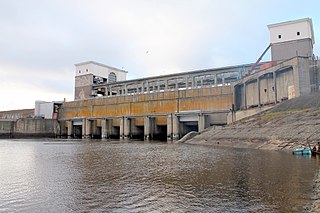
Rybinsk Hydroelectric Station or Rybinsk GES is a hydroelectric station on the Volga and the Sheksna rivers in Yaroslavl Oblast near the Rybinsk town. It is the third of the Volga-Kama Cascade of dams.
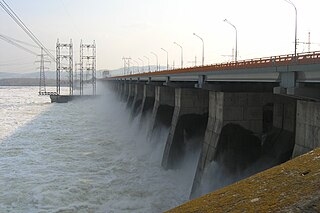
The Zhiguli Hydroelectric Station or Zhigulyovskaya Hydroelectric Station, formerly known as Kuybyshev Hydroelectric Station is a large dam and hydroelectric station on the Volga River, located near Zhigulyovsk and Tolyatti in Samara Oblast of Russia. It is the sixth stage of the Volga-Kama Cascade of dams, and the second of them by in terms of installed power quantum.

Hydroproject is a Russian hydrotechnical design firm. Based in Moscow, it has a number of branches around the country. Its main activities are design of dams, hydroelectric stations, canals, sluices, etc.
According to the International Hydropower Association, Canada is the fourth largest producer of hydroelectricity in the world in 2021 after the United States, Brazil, and China. In 2019, Canada produced 632.2 TWh of electricity with 60% of energy coming from Hydroelectric and Tidal Energy Sources).

RusHydro is a Russian hydroelectricity company. As of early 2012 it had a capacity of 34.9 gigawatts. In late 2009, it was the world's second-largest hydroelectric power producer and is the country's largest power-generating company and the largest successor to RAO UES. The conglomerate, which is partly government-owned, underwent a major consolidation beginning in July 2007. As of 2011, the head of the company was Evgeny Dod. Its head office is in Obruchevsky District, South-Western Administrative Okrug, Moscow. In 2021, the company's revenue amounted to 190 billion rubles.
The Tash-Kömür Hydro Power Plant is a hydroelectric power plant on the river Naryn in Tash-Kömür, Kyrgyzstan. Completed between 1985 and 1987, it is one of three hydro power plants on the river Naryn near Tash-Kömür, 14 km upstream from the Shamaldy-Say Hydroelectric Power Station. It has 3 individual turbines with a nominal output of around 150 MW and a total nominal capacity of 450 MW. The power plant's dam is 75 m (246 ft) tall, creating a 140,000,000 m3 (113,500 acre⋅ft) reservoir of which 10,000,000 m3 (8,107 acre⋅ft) is active for power generation.
The Kambar-Ata Dam is a proposed dam on the Naryn River in central Kyrgyzstan. One of six planned to be built on the river, it will become one of the largest dams in the world at approximately 275 metres (902 ft) high and containing about 370 million cubic metres of rock and earth. The Kambar-Ati-1 Hydro Power Plant at the base of the dam will have the capacity to generate around 2,000 megawatts of electricity. The project will be constructed jointly with Russia and possibly Kazakhstan as well.

The Boguchany Dam is a large hydroelectric dam on the Angara River in Kodinsk, Krasnoyarsk Krai, Russia. It has an installed capacity of 2,997 MW. Construction of the power plant was completed when a ninth and final generator was brought online in January 2015.

On 17 August 2009, a turbine in the hydroelectric power station of the Sayano-Shushenskaya Dam near Sayanogorsk in Russia failed catastrophically, killing 75 people and severely damaging the plant. The turbine hall was flooded, and a section of its roof collapsed. All but one of the ten turbines in the hall were destroyed or damaged. The entire power output of the plant, totalling 6,400 megawatts, was lost, leading to widespread power outages in the area. An official report on the accident was released in October 2009.
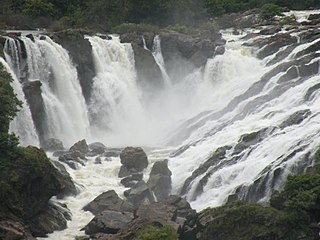
India is 5th globally for installed hydroelectric power capacity. As of 31 March 2020, India's installed utility-scale hydroelectric capacity was 46,000 MW, or 12.3% of its total utility power generation capacity. Additional smaller hydroelectric power units with a total capacity of 4,683 MW have been installed. India's hydroelectric power potential is estimated at 148,700 MW at 60% load factor. In the fiscal year 2019–20, the total hydroelectric power generated in India was 156 TWh with an average capacity factor of 38.71%.

The Zeya Dam is a concrete gravity dam on the Zeya River by the town of Zeya, Amur Oblast, Russia, north of the Chinese border. On average the Zeya Hydroelectric Power Station generates 4.91 TWh of electricity per year. It is equipped with 6 hydro-turbines, 4 with capacity of 225 MW and 2 with capacity of 215 MW.

The Votkinsk Hydroelectric Station is a dam and hydroelectric power station on the Kama River along the border of Perm Krai and Udmurtia, Russia. It is 30 km (19 mi) south of Votkinsk and its main purpose is power generation and navigation. The power station has a 1,100 MW installed capacity and the dam also supports a ship lift. Construction on the dam began in 1955, the first generator was operational in 1961 and the last in 1963. The entire project was complete in 1965.
Renewable energy in Russia mainly consists of hydroelectric energy. Russia is rich not only in oil, gas and coal, but also in wind, hydro, geothermal, biomass and solar energy – the resources of renewable energy. Practically all regions have at least one or two forms of renewable energy that are commercially exploitable, while some regions are rich in all forms of renewable energy resources. However, fossil fuels dominate Russia’s current energy mix, while its abundant and diverse renewable energy resources play little role.

The Uglich Hydroelectric Station or Uglich GES is a hydroelectric station on the Volga River in Uglich in Yaroslavl Oblast, Russia, and is the first of the Volga-Kama cascade of dams. It began operating on December 8, 1940, making it one of the oldest hydroelectric plants in Russia. The 120-MW plant is operated by RusHydro. There is also a Russian hydropower museum located at the hydroelectric plant dedicated to the development of hydropower.

Hydroelectricity is currently China's largest renewable energy source and the second overall after coal. According to the International Hydropower Association, China is the worlds largest producer of hydroelectricity as of 2021. China's installed hydroelectric capacity in 2021 was 390.9 GW, including 36.4 GW of pumped storage hydroelectricity capacity, up from 233 GW in 2011. That year, hydropower generated 1,300 TWh of power, an increase of 68 TWh over 2018 when hydropower generated 1,232 TWh of power, accounting for roughly 18% of China's total electricity generation.
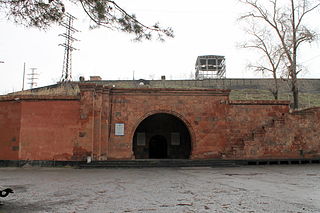
Sevan–Hrazdan Cascade is a complex of hydroelectric power plants on the Hrazdan River and its tributaries between the Lake Sevan and Yerevan in Armenia. They use irrigation water flow from the Lake Sevan and streams waters of Hrazdan River. The cascade is owned by the International Energy Corporation (IEC), a subsidiary of Tashir Group owned by Samvel Karapetyan.
